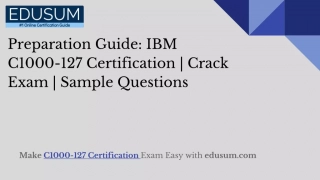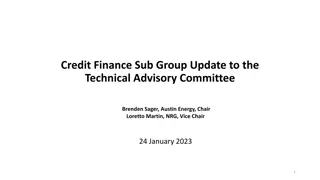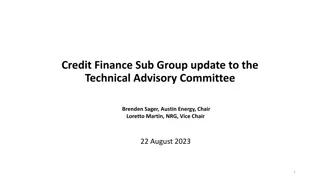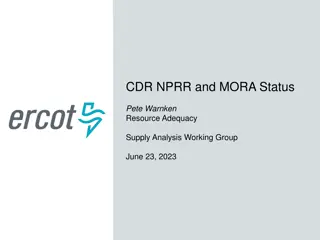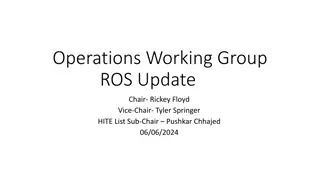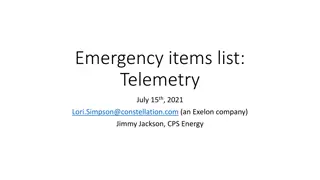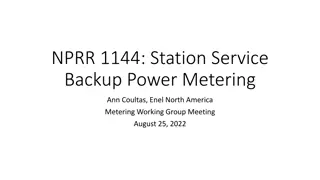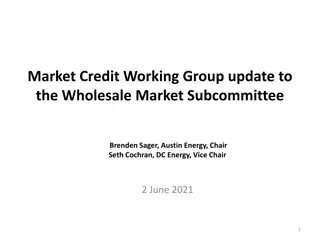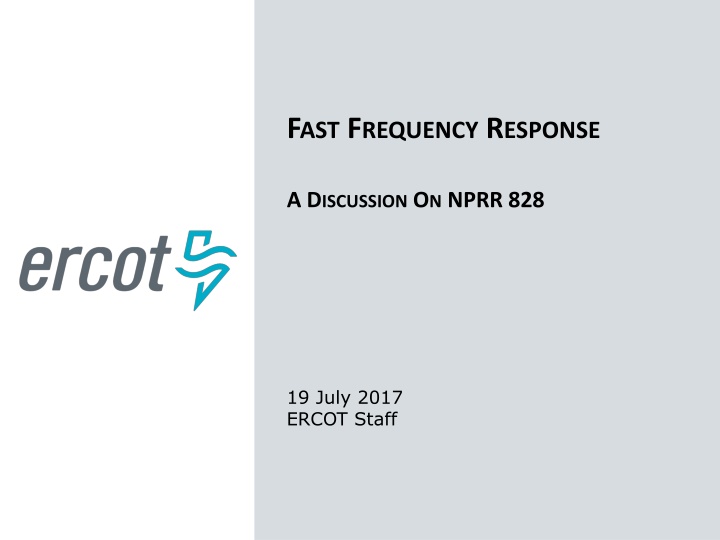
Fast Frequency Response (FFR) in Power Grid Management
"Learn about Fast Frequency Response (FFR) and its role in power grid management. Explore how FFR works, who can provide it, its benefits, limitations, and expectations during different operating conditions. Discover the importance of FFR for maintaining grid stability and reliability."
Download Presentation

Please find below an Image/Link to download the presentation.
The content on the website is provided AS IS for your information and personal use only. It may not be sold, licensed, or shared on other websites without obtaining consent from the author. If you encounter any issues during the download, it is possible that the publisher has removed the file from their server.
You are allowed to download the files provided on this website for personal or commercial use, subject to the condition that they are used lawfully. All files are the property of their respective owners.
The content on the website is provided AS IS for your information and personal use only. It may not be sold, licensed, or shared on other websites without obtaining consent from the author.
E N D
Presentation Transcript
FAST FREQUENCY RESPONSE A DISCUSSION ON NPRR 828 19 July 2017 ERCOT Staff
Discussion Outline What is Fast Frequency Response (FFR)? Who can provide FFR? What are the benefits of having FFR? What limitations will be applied on FFR? What can be expected from FFR providers during normal & EEA conditions?
What is Fast Frequency Response (FFR)? Fast Frequency Response (FFR) The automatic self-deployment and provision by a Resource of their full response within 30 cycles after frequency meets or drops below a preset threshold or via an ERCOT Verbal Dispatch Instruction (VDI). FFR includes Resources capable of automatically self-deploying and providing their full Ancillary Service Resource Responsibility within 30 cycles after frequency meets or drops below a preset threshold and sustaining a full response for at least 15 minutes. Once recalled, Resources providing FFR must restore their full RRS Ancillary Service Resource Responsibility within 15 minutes after cessation of deployment or as otherwise directed by ERCOT. 3 PUBLIC 3
Fast Frequency Response (FFR) Resource providing FFR Load Resource providing RRS will support frequency at 59.85 Hz* or higher. support frequency at 59.7 Hz. 2014 2015 2016 2017 1800 1500 1200 MW Loss (MW) 900 600 300 LR Trigger Frequency Event Count Year<= Hz_C 59.7 0 59.70 59.75 59.80 59.85 59.90 59.95 60.00 60.05 60.10 59.8 59.85 -300 FFR Trigger Op 1 FFR Trigger Op 2 2015 2016 2017 Totals 0 0 0 0 2 3 2 7 9 11 6 26 -600 Frequency at C-point (Hz) *This will be used to identify text in this deck that is different from NPRR 828 and is captured in the draft comment. PUBLIC 4 4
Fast Frequency Response (FFR) Resource providing FFR Load Resource providing RRS will response frequency is at/below frequency threshold. 30 cycles includes delay time of under-frequency relay and breaker operation time. automatically in provide cycles full after respond in 30 cycles, as well. 30 PUBLIC 5 5
Fast Frequency Response (FFR) Resource providing FFR Load Resource providing RRS will sustain full response for 15 minutes* or till ERCOT recalls deployment, whichever occurs first. sustain response till deployment is recalled. 2014 2015 2016 2017 2000 1500 1000 MW Loss (MW) 500 FFR Response 0 00:00 01:00 02:00 03:00 04:00 05:00 06:00 07:00 08:00 09:00 10:00 11:00 12:00 13:00 14:00 15:00 Frequency Event Count Year>= Min 5 8 10 -500 2015 2016 2017 Totals 23 29 6 58 0 4 2 6 0 0 1 1 -1000 Frequency Recovery Time (sec) PUBLIC 6 6
Recovery Times Historic Trend DELTA (HZ) TRIPPED RESOURCE #1 TRIPPED RESOURCE #2 CALCULATED MW LOSS TOTAL RECOVERY TIME TIME @A HZAT A HZAT C HZAT B 0.1173 XYX-1 703 59.968 59.879 59.897 7/21/2016 14:53 0:08:32 0.0672 XYZ-2 XYZ-3 393 59.995 59.927 59.947 7/30/2016 16:39 0:09:08 0.0722 XYZ-4 437 60.016 59.923 59.944 9/18/2016 12:00 0:09:50 0.0424 XYZ-5 419 59.978 59.922 59.947 9/19/2016 16:23 0:08:46 0.1189 XYZ-6 811 60.006 59.787 59.913 3/15/2017 1:36 0:09:53 0.0797 XYZ-7 727 59.951 59.804 59.892 3/29/2017 19:54 0:10:53 7 PUBLIC 7
Fast Frequency Response (FFR) Resource providing FFR Load Resource providing RRS will restore and become available for next event within 15 minutes after deployment ends. *after deployment ends, may not withdraw energy from the grid till frequency recovers to 60 Hz. can take up to 3 hours to reset after deployment ends. PUBLIC 8 8
Fast Frequency Response (FFR) Resource providing FFR Load Resource providing RRS can be deployed via Verbal Dispatch instructions during EEAs. upon such obligated to sustain response for 15 minutes or till ERCOT recalls deployment, whichever occurs first. can be deployed similarly during EEAs as well. upon such obligated to sustain response till the deployment is recalled. deployment, are deployment, are *after deployment ends,will only be allowed to withdraw enrgy from the grid when the EEA has ended and recovered above 59.95 Hz. frequency has PUBLIC 9 9
Who can provide FFR? Generation Resources & Load Resources may provide FFR upto tested capability. Storage Loads with shorter down-time FFR Qualification ERCOT will qualify resources that can provide FFR via qualifications tests. Passing metric for the test will be, Resource s response must be within 95% and 110% of Min(RRS, MW deployment). (MW deployment = telemetered HSL/MPC LSL/LPC) AND Resource must sustain the response for 15 minutes. ERCOT may revoke a resource s FFR qualification if it has 2 performance failures during actual deployments (manual or frequency triggered) within a rolling 365-day period. Resource can requalify for FFR after 6-months. Documentation will be required to identify actions taken to correct performance deficiencies along with the test. 10 PUBLIC 10
FFR Performance Evaluations FFR Performance Evaluations For any FFR deployment event, ERCOT will collect one or more of the following data: High speed event data from Resources that are not deployed via breaker action; High speed event data from recorders at ERCOT s primary and back-up facilities; High speed event data from phasor measurement units available to ERCOT; and Telemetry data for all Resources providing FFR during the event; and Recording of ERCOT Frequency (Hz) and MW output with a resolution of no less than 32 samples* per second. Following metric will be used for evaluating response Resource deployed in 30 cycles after frequency reached trip threshold (or 10 minutes for manual deployment via VDI), AND Resource sustained the response for at least 15 minutes or till ERCOT recalls deployment, whichever occurs first, AND Resource was reset and made available for next event within 15 minutes after deployment ended. 11 PUBLIC 11
What are the benefits of having FFR? 1. Early response from FFR will aid in preserving Load Resource providing RRS for more severe events. With 59.85 Hz or higher frequency trigger, FFR will deploy more often than Load Resources in response to frequency events; With Resources providing fast response, most frequency events will not trigger Load Resources deployment. Thus preserving frequency response capabilities from Load Resources to be available for (the next) severe event. 2. Short restoration time for resources providing FFR will limit ERCOT s exposure (i.e. inability to respond) to next event of similar magnitude. Upon recall of deployment, Resources providing FFR will reset and become available to respond to another event within 15 minutes. If a frequency event triggers deployment of RRS from Load Resources, for a 3 hour duration following such an event, ERCOT may not have adequate frequency responsive resources to respond to a large trip (~2700 MW trip). This is because Load Resources providing RRS after a deployment have 3 hours to reset and become available to respond to another event. 12 PUBLIC 12
What are the benefits of having FFR? 3. With the appropriately selected trip settings, FFR can help mitigate Critical Inertia and facilitate further increased penetration levels of renewables in ERCOT. Critical Inertia 525 MW FFR @59.8 Hz is assumed. 100 90 90 90 88 86 90 80 70 60 GW*s 50 40 30 20 10 0 10-cycle FFR 15-cycle FFR 20-cycle FFR 30-cycle FFR No FFR Under 100 GW*s Inertia condition, 30-cycle / 20-cycle FFR is only able to slow down frequency decay by 6 ms / 8 ms before UFLS set-point (59.3Hz) being reached. Therefore, its impact on mitigating critical inertia is minimum compared to faster FFR services (10/15-cycle FFR). 13 PUBLIC 13
FFR (59.85 Hz) Limit* Determination Case1 Inertia:100 GW*s 1150 MW PFR, 59.85 Hz & 30 cycles FFR 420 MW FFR 240 MW FFR 0 MW FFR 60.15 60.12 292 MW Generation Loss 60.09 60.06 60.03 Frequency (Hz) 60.00 59.97 59.94 59.91 59.88 59.85 59.82 59.79 0 2 4 6 8 10 12 14 16 18 20 Time (s) 14 PUBLIC 14
Operational Expectations Normal During normal , non-EEA conditions, Resource providing FFR will automatically deploy when frequency reaches or drops below 59.85 Hz* (or a higher threshold) and provide full response within 30 cycles 30 cycle includes delay time of under-frequency relay and breaker operation time. will sustain response for 15 minutes* or till ERCOT recalls deployment, whichever occurs first. will restore full A/S responsibility within 15 minutes after deployment ends. *after deployment ends, may not withdraw energy from the grid till frequency recovers to 60 Hz. 15 PUBLIC 15
Operational Expectations EEA During EEA conditions, Resource providing FFR may be deployed through Verbal Dispatch Instruction (VDI). will provide full response within 10 minutes of receiving VDI. will sustain response for 15 minutes* or till ERCOT recalls deployment, whichever occurs first. will restore full A/S responsibility within 15 minutes following cancellation of an EEA. *after deployment ends, may only withdraw energy from the grid when the EEA has ended and frequency has recovered above 59.95 Hz. 16 PUBLIC 16
Divider Slide DISCUSSION Divider Slide (optional) PUBLIC 17

